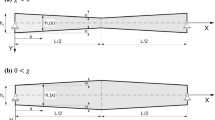Summary
If in a transversally vibrating beam of fiber-reinforced material the fibers are much stiffer than the matrix material, the influence of shear might be dominant even for wave lengths which are large as compared with the thickness of the beam. It is shown here by asymptotic solutions of the threedimensional equations of linear elasticity for transversal isotropy that a dimensionless parameterp: = π 2H/Λ √E/G characterizes the dynamical behaviour (2H: thickness, Λ: wave length,E: longitudinal elasticity modulus,G: transversal shear modulus). The influence of shear becomes apparent forp ∼ 1 even though 2H/Λ ≪ 1. Ifp is much larger than 1 (strong anisotropy), the wave velocity is almost equal to the shear velocity even for large wave lengths, the main part of the cross section is subject to uniformly distributed shear stresses, boundary layers of large bending normal stresses vanishing rapidly towards the core of the cross section travel along with the shear wave, the beam acts as a “sandwich” structure. For all degrees of anisotropy, explicite analytical expressions for stress and displacement distributions as well as for the wave velocity can easily be derived for various shapes of cross sections. This has been illustrated for a circle and a rectangle.
Übersicht
Bei Querschwingungen von Balken aus faserverstärktem Material mit Fasern, die viel steifer als die Matrix sind, kann der Einfluß von Schub sogar für größere Wellenlängen dominieren. Durch asymptotische, Lösungen der dreidimensionalen Gleichungen für lineare Elastizität und Transversalisotropie wird hier gezeigt, daß ein dimensionsloser Parameterp: = π 2H/Λ √E/G das dynamische Verhalten des Balkens charakterisiert (2H: Dicke, Λ: Wellenlänge,E: Elastizitätsmodul in der Längsrichtung,G: Schubmodul in der Querrichtung). Der Schubeinfluß wird stark fürp ∼ 1 auch dann, wenn 2H/Λ≪1 ist. Wennp viel größer als 1 wird (starke Anisotropie), dann erreicht die Wellengeschwindigkeit beinahe die Schubgeschwindigkeit sogar für große Wellenlängen, dann ist der Hauptteil des Querschnitts gleichförmig verteilten Schubspannungen ausgesetzt, und Grenzschichten mit großen Biegespannungen, die gegen den Querschnittskern sofort verschwinden, wandern mit der Schubwelle zusammen. Der Balken verhält sich dann wie eine „Sandwichstruktur”. Für alle Anisotropiebereiche können explizite analytische Ausdrücke für Spannungs- und Verschiebungsverteilungen sowie für die Wellengeschwindigkeit bei verschiedenen Querschnittsformen hergeleitet werden. Dies wird für den Kreis und das Rechteck illustriert.
Similar content being viewed by others
References
Spencer, A. J. M.: Deformation of fibre reinforced materials. Oxford 1972
Rogers, T. G.; Pipkin, A. C.: Small deflection of fibre reinforced beams or slabes. J. Appl. Mech. 38 (1971) 1047
Mitropoulos, C. S.: Zur Theorie der schwach- und starkanisotropen faserverstärkten Rotationsschalen. Dissertation No. 6317, ETH Zürich 1978
Kolsky, H.: Stress waves in solids. Oxford 1953
Sayir, M.; Mitropoulos, C. S.: On elementary theories of linearelastic beams, plates and shells. J. Appl. Math. Phys. (ZAMP) 31 (1980) 1
Katz, H. S.; Milewski, J. V.: Handbook of fillers and reinforcements for plastics London 1978
Jahnke, E.; Emde, F.: Funktionentafeln. Leipzig 1938
Everstine, G. C.: Stress concentrations and boundary layers in fibre reinforced material. Ph. Dissertation, Brown University 1971
Timoshenko, S.: On the correction for shear of the differential equation for transverse vibrations of prismatic bars. Phil. Mag. 41, Ser. 6 (1921) 744
Author information
Authors and Affiliations
Additional information
Meinem verehrten Lehrer, Herrn Professor Dr. Hans Ziegler, zum 70. Geburtstag gewidmet
I would like to thank Professor H. Kolsky forthe fruitful discussions concerning the physical aspects of this paper.
Rights and permissions
About this article
Cite this article
Sayir, M. Flexural vibrations of strongly anisotropie beams. Ing. arch 49, 309–323 (1980). https://doi.org/10.1007/BF02426910
Received:
Issue Date:
DOI: https://doi.org/10.1007/BF02426910




